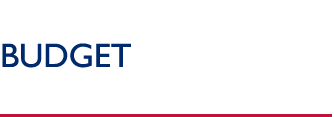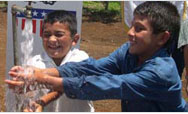 |
|
 |
 |
|
 |
 |
 |
USAID Information:
External Links:
|
|
 |
 |
|
Ecuador
The Development Challenge: Ecuador is recovering from the disastrous, twin effects of the interruption
in the constitutional order and the collapse of the economy and the banking system that befell the country
in 1999. Rampant inflation and capital flight in that same year caused Ecuador to dollarize the economy
almost literally overnight, and the country experienced five changes in government in a little over a year.
In short, the end of the century saw Ecuador in economic and political shambles, bordering on social
chaos. However, Ecuador has made significant strides in recovering from the low points of 1999. The
government completed the country’s first International Monetary Fund (IMF) stand-by agreement since
the 1980s and the 2002 presidential election was deemed by international observers as the fairest in
Ecuador’s history. A former army colonel, Lucio Gutierrez won the 2002 elections and took office in
January 2003. This year also marks the 25th anniversary of Ecuador’s return to democratic elections and
civilian rule.
 |
|
Please note: All documents are in pdf format |
Nevertheless, much remains to be done before development, stability, and prosperity are assured. In
2003, Transparency International ranked Ecuador as the 20th most corrupt country out of 133, as
perceived by business people, academics, and risk analysts. Lack of competitiveness fuels concerns
about the stability and future of dollarization and further needed macroeconomic reforms. Although a real
gross domestic product (GDP) growth of 3% was originally estimated for 2003, this figure has been
adjusted to 2.2%, based on the poor second-quarter results, which showed a quarter-on-quarter
contraction of 0.8%. The total external debt estimated for 2003 represents 59% of GDP and debt service
estimated as a percentage of earnings from exports reaches 20.8%. Unemployment rates remain close
to 10%, while underemployment is approaching 50%. Over 60% of the population lives in poverty and
only 40% has access to safe water.
Furthermore, Ecuador continues to suffer from the destabilizing effects of the drug trafficking activities in
neighboring countries and the collateral effects in security. Communities along Ecuador’s northern border
are especially vulnerable to drug related criminal activity and incursions by guerillas across the Colombian
border. Finally, the destruction of natural ecosystems is threatening Ecuador’s impressive biodiversity.
The country that is one of the world’s richest biodiversity centers and holds 10% of the earth’s plant
species and 18% of bird species, now also has the second highest deforestation rate in South America.
The United States and Ecuador maintain close ties based on mutual interests in upholding democratic
institutions; combating drug-trafficking; combating terrorism; fostering Ecuador's economic development;
building trade, investment, and financial ties; combating poverty; and cooperating and participating in
inter-American organizations. Ecuador’s position in the heart of South America’s most conflicted region
also underscores the country’s importance to U.S. interests. A democratic and prosperous Ecuador can
help restrain the spread of illegal drugs and violence across the Northern Andes.
The USAID Program: The Data Sheets provided below cover the five strategic areas for which USAID is
requesting 2004 and 2005 funds: biodiversity conservation; democracy and governance; economic
opportunities; and development of Ecuador’s northern and southern borders. USAID supports the
conservation of biologically important regions within Ecuador’s protected area systems. USAID also
seeks to increase support for the democratic system by strengthening the transparency and accountability
of democratic institutions, fostering greater inclusiveness of disadvantaged groups in democratic
processes, and increasing consensus on policies critical to democratic consolidation. USAID aims at
reducing rural and urban poverty by helping to develop a strong and sustainable microfinance sector in
Ecuador and by improving the macroeconomic environment for more equitable growth. USAID continues
working with the Government of Ecuador to contain the spread of a coca/cocaine economy into Ecuador
by supporting the construction of social and productive infrastructure projects and providing alternative
income opportunities for small and medium-sized farmers. Finally, USAID assists in the improvement of
social and economic conditions of inhabitants along the Peru-Ecuador border, encourages equitable
development on both sides of the border, and fosters border integration.
USAID does not currently have a health program in Ecuador. However, available health data suggests
deterioration in major health indicators since the closing of the health objective in September 2000.
Ecuador could benefit from targeted technical assistance in the health sector. Staff from the Latin America
and the Caribbean (LAC) Bureau and the Global Health Bureau are working with the USAID mission in
Ecuador to define the type of activities that might be feasible for assistance in following years.
Other Program Elements: In addition to activities described in the program data sheets, USAID’s office
of Private and Voluntary Cooperation within the Democracy, Conflict, and Humanitarian Assistance
Bureau manages Ecuador by increasing their capacity to produce, utilize, and market agricultural
commodities through cost-effective and environmentally sustainable methods.
USAID manages three South America regional programs that involve Ecuador: 1) the Andean Region
Trade Capacity Building program, which enhances capacity of the Andean Community (CAN) as a partner
in the negotiations leading to the creation of the Free Trade Area of the Americas (FTAA) and strengthens
regional capacity to implement the rules of trade emerging from FTAA negotiations; 2) the Centers of
Excellence for Teachers Training (CETT) in the Andean region, training teachers who work in
disadvantaged communities to improve the quality of reading instruction; by the end of FY 2003, 527
teachers and 92 school directors participated in this training program; and 3) the Amazon Malaria initiative
which is a malaria control program.
In order to improve current health information, the LAC Bureau is contributing FY 2004 funds to support a
national household health survey that will provide detailed data for program planning. Subsequent
programming, funding levels, and management approaches will be determined based on availability of
funds, LAC Bureau guidance, and results from the survey. The LAC Bureau provisionally included Child
Survival and Health (CSH) funding in the LAC Regional Program's FY 2005 budget, as a basis for
possible health programming which will be defined in FY 2004.
Other Donors: USAID has worked with the International Monetary Fund (IMF), the World Bank, the Inter-
American Development Bank (IDB), and the Andean Development Corporation (CAF) to support GOE
initiatives that have brought inflation under control, reduced GOE budget deficits, and stabilized a
financial system that was spinning out of control. USAID’s assistance has been instrumental in enabling
the GOE to obtain balance of payments assistance under the stand-by agreement with the IMF. Overall
development assistance to Ecuador in 2002 totaled approximately $236 million; the United States
accounted for 46% of the grant assistance and continues to be the largest donor, followed by the
European Commission and Japan. The IDB’s strategy for Ecuador is centered on economic stabilization
and recovery of growth capacity, poverty reduction, and management of infrastructure with private sector
participation. The World Bank is working to consolidate Ecuador’s macroeconomic framework, broaden
access to economic resources, and strengthen government institutions. The CAF provides funding
mainly for infrastructure projects.
Back to Top ^
|


